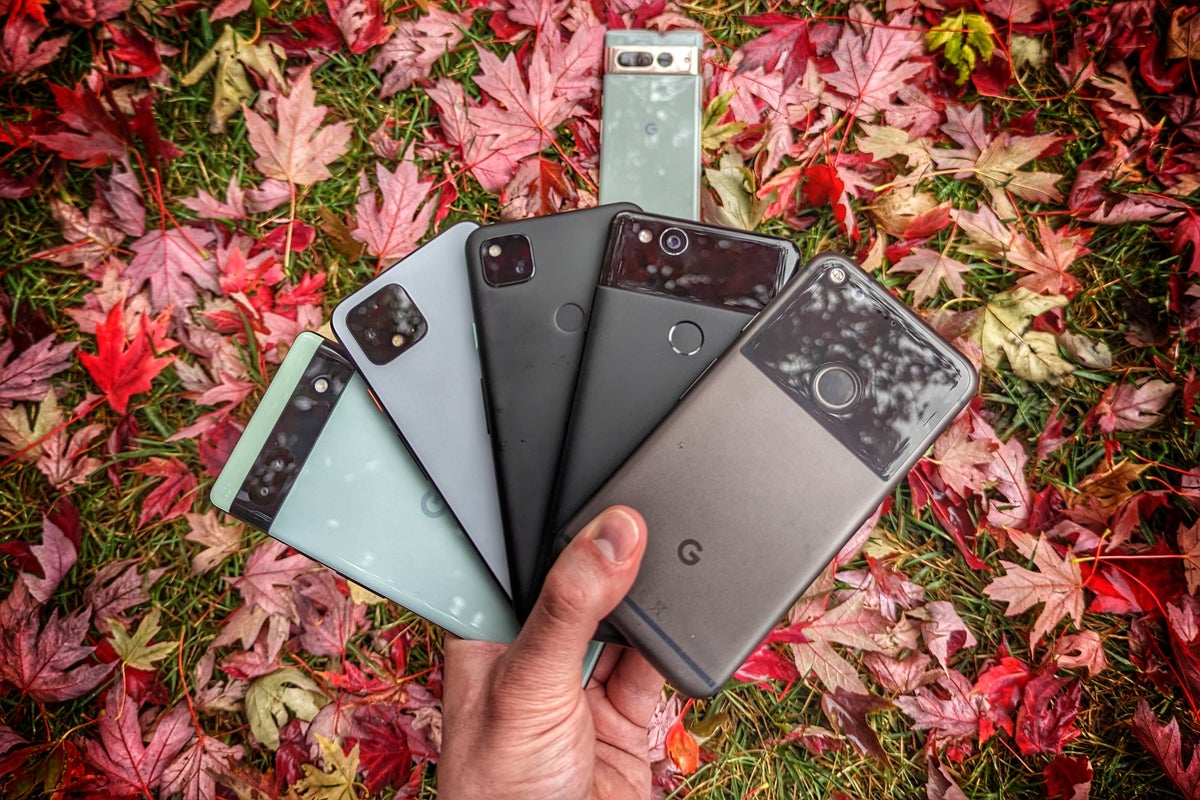So you've got a Pixel — any ol' Pixel. Or maybe even a relatively new Pixel. And you're thinking about getting Google's glowing new Pixel 7 phone or perhaps its Pixel 7 Pro sibling.
It's tempting, I know. (We all love shiny stuff!) But is it actually worth your while to get the Pixel 7, or are you better off hanging onto your current Pixel for a while longer?
Having lived with both the Google Pixel 7 and the Pixel 7 Pro for a full week now — and coming from the perspective of someone who personally owns a Pixel 6, has owned plenty of Pixels before that, and has spent a significant amount of time with every single Pixel model — lemme tell ya: There isn't a simple, one-size-fits-all answer.
But there is some practical guidance I can give you based on my experiences with these latest Googley phones and my intimate knowledge of their assorted Pixel predecessors. And the most important variable to consider is which specific Pixel you're packin' in your suspiciously sticky palm.
So think it through with me, won't ya? And whether you end up snagging the latest and greatest Pixel or stickin' with your current model, be sure to mosey your way over to my free Pixel Academy e-course next. It'll teach you all sorts of useful new stuff your phone can do for you, no matter which Pixel you end up possessing.
Google Pixel 7 vs. Pixel 6
We'll start with the most recent Pixels and specifically the smaller Pixel 6 — the same sumptuous phone I've got in my oversized man-pocket this second.
And this one's a somewhat two-pronged answer: First, your Pixel 6 is still perfectly peachy and set to get Android updates for another solid two years. You've got no particularly pressing reason to make the leap to the Pixel 7, and you'd certainly be fine to stick with your current phone for another year or two.
That being said, as someone with the Pixel 6, there's a decent chance you're a tech addict and the type of person who simply likes having the best available product. So if you're looking for a reason to upgrade, I'll give you a few (with advance apologies to your wallet):
- Face Unlock: The Pixel 7 brings it back from the dead, and while it's undeniably imperfect — the system's hit and miss in dim lighting, and because it works through the standard camera and without any specialized hardware, it isn't as secure as a fingerprint and can't be used for any in-app authentication — it's still a nice added convenience, and you'll almost certainly appreciate its presence.
- Fingerprint speed: Speaking of authentication, the Pixel 7 series moves to a new fingerprint sensor that's noticeably snappier and more consistent than what the Pixel 6 gives you. It still isn't at the level of the old rear-facing sensors of Pixels yore, but as far as these in-display versions go, it's about as good as it gets.
- Size: If you're someone who prefers a smaller phone, the Pixel 7 is a nib smaller than the Pixel 6 — with a slightly narrower screen and a noticeably more svelte torso.
 JR
JR
The Google Pixel 7 (left) next to the Pixel 6 (right)
Given that shrinkage, the upgrade I'd actually suggest contemplating is a step up to the larger land of the Pixel 7 Pro — which is what I'm seriously chewing over myself. The Pro phone doesn't feel that overwhelmingly big after a year with the regular Pixel 6, and going Pro gives you the advantage of a bunch of enticing new camera capabilities — like the Pixel 7 Pro's wildly impressive long-distance zooming capabilities and its new super-up-close macro photography prowess.
 JR
JR
A macro shot taken with the Pixel 7 Pro camera. (Click to enlarge.)
The Pixel 7 Pro also has a substantially less curved screen than the 6 Pro before it, which largely addresses my complaints with that earlier model. The curve on this year's phone is quite subtle and more reminiscent of the slight edge sloping we saw way back with the Nexus 4 than the extreme and experience-harming slant in last year's model.
Last but not least, there's the moolah factor to mull over: The Pixel 7 starts at 600 bucks, while the Pixel 7 Pro costs a cool $900. But:
- If your Pixel 6 is in good condition, Google will give you $440 for it as part of a trade-in. Best Buy will up that number to $470 in the US. (It probably goes without saying, but this stuff is bound to vary in other locales.)
- Either store will also throw in a $100 store credit if you buy a Pixel 7 and a $200 credit if you buy a Pixel 7 Pro in the US.
- With both of those factors combined — and assuming you have something worthwhile to spend the credit on in the months ahead — you'd effectively be getting $540 to $570 off the cost of a Pixel 7 or $640 to $670 off the cost of a Pixel 7 Pro.
So with that in mind, a new Pixel 7 would actually only cost you 30 to 60 bucks if you're trading in your Pixel 6, while a Pixel 7 Pro would run you roughly $230 to $260.
The regular Pixel 7 upgrade almost seems like a no-brainer in that scenario — I mean, really, why not?! — while the Pixel 7 Pro ventures into "hell of a deal" and "easy to justify if you're already feeling the urge, anyway" terrain.
➜ The verdict, in short: If you're itchin' for something new and you're the sort of person who geeks out over the finer points of mobile technology (hiya!), you'll be thrilled with the Pixel 7 upgrade coming from a regular Pixel 6. The most significant change will come with moving from the regular Pixel 6 to the Pixel 7 Pro. That being said, you certainly don't need it, and the purely sensible advice would be to hang onto your current phone for a while longer (though the trade-in possibility can give you some extra excuses if you really want to talk yourself into it).
Google Pixel 7 vs. Pixel 6 Pro
For anyone palming the plus-sized Pixel 6 Pro, the same exact advice we just went over also applies to you — with a few key exceptions:
- First, the size factor isn't a relevant factor for you, unless you're wanting to bump down to something smaller with the regular Pixel 7 model.
- Second, the camera upgrades from the Pixel 6 Pro to the Pixel 7 Pro won't be quite as substantial, since you've already got that zesty zooming goodness. The zooming quality does get a bit better with the 7 Pro, though, and you also gain the new macro photography magic — along with a smattering of other interesting new modes and options.
- And third, your trade-in value for a good condition Pixel 6 Pro in the US jumps up to $480 from Google or $500 from Best Buy along with that $100 store credit toward a Pixel 7 or $200 credit for a Pixel 7 Pro.
That means you'd effectively be paying a mere 20 bucks for a regular Pixel 7 from Google or basically getting the phone free from Best Buy, provided your 6 Pro is in reasonable condition. If you go the Pixel 7 Pro route, you'd bring the phone's price down to $220 from Google or $200 from Best Buy. Not too shabby.
➜ The verdict, in short: Like our regular Pixel 6 pals, you definitely don't need to make this upgrade. But if you want to, it'll be a nice little improvement for you — albeit a much more subtle one than folks will see going from the regular Pixel 6 to the Pixel 7 Pro. And if you find yourself craving Google's latest and greatest, the trade-in value and current store credit promotion can make it pretty easy to rationalize.
Google Pixel 7 vs. Pixel 6a
Got Google's most recent midrange Pixel model? Moving to the Pixel 7 or Pixel 7 Pro would absolutely be an improvement for you, but that's in large part because you're moving from a more budget-minded proposition into premium flagship terrain.
That means you'll get a fancier-feeling phone body (for whatever that's worth to you), along with lots of extra bells and whistles and niceties — including all the new camera goodies we just went over.
The Pixel 7 and Pixel 7 Pro are also in a completely different league when it comes to processing power, which can make the phone feel a fair bit snappier. That being said, the Pixel 6a is certainly no slouch with performance for most average-mammal needs, and you may or may not notice any obvious difference in your day-to-day use (especially if you aren't doing a ton of multitasking and other high-resource-requiring work).
The biggest question to ask yourself is why you went with the Pixel 6a in the first place. If it's because of the price and value, then moving up to the Pixel 7 or Pixel 7 Pro probably isn't an advisable move. Your 6a still has a solid few years of active software support under its belt, and nothing about the upgrade is gonna dramatically revolutionize your core user experience or what your phone's capable of doing — outside of photography, at least, but even there, we're talking more niceties and added abilities as opposed to core competency.
➜ The verdict, in short: If you're jonesing for a more premium Pixel experience, you'll be delighted by the move to a Pixel 7 or Pixel 7 Pro — but that's mostly because you're hopping from one product tier to another. For most people who bought the 6a in the first place, sticking with that phone for another year or two will make more sense.
Google Pixel 7 vs. Pixel 5
The Pixel 5 is an unusual Pixel in that it's the one flagship-level Google phone that was more of a value play than a high-end, premium-feeling product.
With that in mind, the Pixel 7 or Pixel 7 Pro would be a substantial upgrade for you, all around, and a meaningful leap forward.
But your current phone is also still perfectly fine. It'll get Android updates through October 2023.
So this one really comes down to a matter of want over need. If you want it, it's well worthwhile, and you'll certainly see enough of a difference to justify the change. But you definitely don't need it, and if you aren't feeling the urge to get something new, there's really no reason not to stick with what you've got.
➜ The verdict, in short: The Pixel 7 or Pixel 7 Pro would be a nice upgrade for you but by no means a necessary one. Ask yourself how much you truly want one of the devices and how much you can stomach the cost for what's without a doubt an inessential purchase.
Google Pixel 7 vs. Pixel 5a
The story with the Pixel 5a is honestly pretty similar to what we just said with the Pixel 5 — especially since the Pixel 5 was more of a midrange model.
The Pixel 7 or Pixel 7 Pro would be a significant upgrade from the 5a in every possible measure, and you'd absolutely notice the difference. But your current phone is still fine, and the 5a is set to be supported with Android software updates all the way through August 2024.
Just like with the Pixel 6a, the real question here is how badly you want to move to a more premium, high-end phone experience and how much you're willing to spend to get it.
➜ The verdict, in short: For most 5a owners, there's no pressing reason to upgrade — though going from that phone to the Pixel 7 or Pixel 7 Pro would absolutely be a massive and immediately noticeable improvement, if you simply wanted to give yourself the added niceties of the more premium Pixel path.
Google Pixel 7 vs. Pixel 4
As a former Pixel 4 owner myself, I've got a soft spot in my heart for Google's more experimental Pixel model. Despite the bad rap it got early on, the Pixel 4's Soli radar system genuinely did make the Pixel 4 more useful — even if it only reached a tiny fraction of its potential before Google annoyingly gave up on the concept.
Soli was also one part of what made the Pixel 4's Face Unlock system so effective in practice: The radar would detect when you were picking up your phone and moving it closer to your face, then the Pixel 4's special infrared camera would kick in and quickly recognize your face to let you in — no matter what sort of lighting was involved. The result was near-instant activation and authentication whenever you grabbed your device, which was a pretty incredible advantage to have.
That kind of convenience was tough to leave behind with the subsequent Pixel models, but the Pixel 7 series brings Face Unlock back into the equation — albeit in a less advanced manner, given the loss of Soli and the infrared camera. Still, it softens the blow considerably and makes the move away from the Pixel 4 much more palatable to anyone still hanging onto that phone. Just know that that specific part of the experience won't be quite as good as what you've got now.
Even so, the Pixel 7 or Pixel 7 Pro are probably worth your while to buy. For all its positives, the Pixel 4 is getting pretty long in the tooth at this point. And it's no longer actively receiving operating system updates or security patches as of this month (though Google may end up being gracious and giving you a couple more patches before officially pulling the plug).
Hanging onto a phone that's not rockin' current software is never a fully advisable move. If you really want to keep your Pixel 4 a while longer, you could get away it for another handful of months. But the Pixel 7 or 7 Pro will be a major leap forward for you, and from almost every possible perspective, it's an upgrade worth making.
➜ The verdict, in short: You should think carefully about getting the Pixel 7 or Pixel 7 Pro. It's time — and the return of Face Unlock in some form will make this the first Pixel upgrade that won't require a total compromise in that department.
Google Pixel 7 vs. Pixel 4a
The Pixel 4a is slightly newer than its standard 4 cousin, which means it's scheduled to receive software support through August 2023.
With that in mind, you could easily get away with keeping it for another year yet and then thinking about an upgrade next fall. And since you're on the midrange path now, you may well want to stick with that same route and think about the next Pixel "a" phone instead of taking the full-price, flagship-phone road.
Now, that being said, if you're simply tempted to get the Pixel 7 or Pixel 7 Pro, either device would represent a monumental improvement for you in practically every measure. You will notice the difference in your day-to-day use, and it'll be a very nice upgrade.
But there's also no reason you can't make the most of your current phone and wait another year to make a change — whether you end up shifting over to the premium Pixel path or sticking with the still-perfectly-pleasant and arguably more sensible Pixel "a"-line option.
➜ The verdict, in short: The Pixel 7 or Pixel 7 Pro would be quite the upgrade, but your 4a's got a little more life in it yet. Unless you're just ready for something new and wanting to move to a more premium Pixel experience, there's really no reason not to wait a little longer.
Google Pixel 7 vs. Pixel 3
This one's easy: If you've got the Pixel 3, get the Pixel 7 or Pixel 7 Pro. Your phone's been out of date since early this year, which means you didn't get Android 13, haven't gotten security patches in several months, and won't get any other major software updates moving forward.
That aside, Google's Pixel hardware has come an insanely long way over the past four years. You'll be blown away by what the Pixel 7 or Pixel 7 Pro will be like to use and how impressive of an experience either device will give you.
Plain and simple, it's time. (And the same advice applies to the Pixel 3XL, by the way, which is basically just a bigger version of the same third-generation device.)
➜ The verdict, in short: The Pixel 3 is past its prime and past the point of advisable ownership. If the new Pixels are too pricey for your preference, you could certainly save some money and get the Pixel 6a instead. But one way or another, you need a new phone.
Google Pixel 7 vs. Pixel 3a
Same deal as above: Coming from the midrange "a" path, you might prefer the Pixel 6a, if cost is a concern or you just don't particularly care about the premium phone perks (physical form, camera extras, extra under-the-hood oomph, and all that fun stuff).
But getting a new Pixel of some sort is 100% the advisable thing to do.
➜ The verdict, in short: Get the Pixel 7 or Pixel 7 Pro if you want the best possible Pixel experience, or consider the Pixel 6a if you want to stay on the still-exceptional midrange Pixel path.
Google Pixel 7 vs. Pixel 2 and Pixel 1
This last combined category might be the easiest answer of all: If you're still clinging to the Pixel 2 or the first-gen Pixel 1 model, for Goog's sake, get yourself a new phone.
The Pixel 2 and its XL companion are still on 2020's Android 11 software and haven't received a security update in nearly two years. That aside, the phones themselves are now five years old. And lemme tell ya: We've come a loooong way since their launch.
I've still got my Pixel 2 in my desk drawer. It's bordering on painful to use at this point compared to the current Pixel standard.
And that's even more true for the first-gen Pixel I've got nearby as well. Much as I adore it, that phone is now six years old, stuck on 2019's Android 10 version of the operating system, and three years out of date on security patches.
In any of these scenarios, moving to a Pixel 7 or Pixel 7 Pro will completely blow your mind in terms of how far Google's hardware and software have come and how pleasant and advanced of an experience you'll encounter. But beyond that, they'll also give you an optimally secure and privacy-protecting setup with a level of performance that's in a totally different league from what you've got now.
➜ The verdict, in short: It's well past time for you to upgrade to a more current device, and the Pixel 7 and Pixel 7 Pro are the perfect opportunities to make that move happen.
Don't let yourself miss an ounce of Pixel magic. Sign up for my free Pixel Academy e-course to discover tons of hidden features and time-saving tricks for whatever Pixel you're using!












































